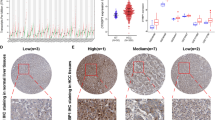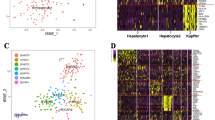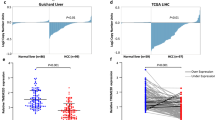Abstract
Our previous studies suggested that chromosome 8p deletion is associated with metastasis of hepatocellular carcinoma (HCC), in which some novel metastasis suppressor genes might be harbored. The present study aimed to identify the metastatic suppressor gene(s). A cDNA chip was constructed with the expressed sequence tags (ESTs) from chromosome 8p and used to compare the difference of expression profiling between the MHCC97-H and MHCC97-L cell lines with different metastatic potentials and similar genetic backgrounds. In all, 10 ESTs were significantly downregulated in MHCC97-H cell line with higher metastatic potential. One full-length gene, HTPAP (phosphatidic acid phosphatase type 2 domain containing 1B), was identified at chromosome 8p12. Sequencing and bioinformatic analyses revealed that HTPAP has 826 bp and encodes a putative protein of 175 amino acids with a transmembrane segment at the NH2 terminus, two protein kinase C phosphorylation site and one tyrosine kinase phosphorylation site. Its expression level in metastatic tumor tissues was much lower than that of primary HCC tissues. Both in vitro and in vivo assays suggested that HTPAP could suppress the invasion and metastasis of HCC. These suggested that HTPAP is a novel metastatic suppressor gene for HCC. The mechanism of the effect of HTPAP on HCC metastasis is not clear yet and deserves further investigation.
This is a preview of subscription content, access via your institution
Access options
Subscribe to this journal
Receive 50 print issues and online access
$259.00 per year
only $5.18 per issue
Buy this article
- Purchase on Springer Link
- Instant access to full article PDF
Prices may be subject to local taxes which are calculated during checkout







Similar content being viewed by others
References
Arai T, Akiyama Y, Yamamura A, Hosoi T, Shibata T, Saitoh K et al. (1998). Int J Cancer 79: 418–423.
Armes JE, Hammet F, de Silva M, Ciciulla J, Ramus SJ, Soo WK et al. (2004). Oncogene 23: 5697–5702.
Berger JC, Griend DV, Stadler WM, Rinker-Schaeffer C . (2004). Anticancer Drugs 15: 559–568.
Bissig H, Richter J, Desper R, Meier V, Schraml P, Schaffer AA et al. (1999). Am J Pathol 155: 267–274.
Bogenrieder T, Herlyn M . (2003). Oncogene 22: 6524–6536.
Eisen MB, Spellman PT, Brown PO, Botstein D . (1998). Proc Natl Acad Sci USA 95: 14863–14868.
Giannelli G, Fransvea E, Marinosci F, Bergamini C, Colucci S, Schiraldi O et al. (2002). Am J Pathol 161: 183–193.
Hussain SA, Ferry DR, El-Gazzaz G, Mirza DF, James ND, McMaster P et al. (2001). Ann Oncol 12: 161–172.
Ishii H, Baffa R, Numata SI, Murakumo Y, Rattan S, Inoue H et al. (1999). Proc Natl Acad Sci USA 96: 3928–3933.
Kauffman EC, Robinson VL, Stadler WM, Sokoloff MH, Rinker-Schaeffer CW . (2003). J Urol 169: 1122–1133.
Keller ET, Fu Z, Yeung K, Brennan M . (2004). Cancer Lett 207: 131–137.
Kujawski M, Sarlomo-Rikala M, Gabriel A, Szyfter K, Knuutila S . (1999). Genes Chromosomes Cancer 26: 253–257.
Letunic I, Copley RR, Schmidt S, Ciccarelli FD, Doerks T, Schultz J et al. (2004). Nucleic Acids Res 32: D142–D144.
Li SP, Wang HY, Li JQ, Zhang CQ, Feng QS, Huang P et al. (2001). J Hepatol 34: 840–849.
Li Y, Tian B, Yang J, Zhao L, Wu X, Ye SL et al. (2004). J Cancer Res Clin Oncol 130: 460–468.
Liao C, Zhao M, Song H, Uchida K, Yokoyama KK, Li T . (2000). Hepatology 32: 721–727.
Liotta LA, Steeg PS, Stetler-Stevenson WG . (1991). Cell 64: 327–336.
Muscheck M, Sukosd F, Pesti T, Kovacs G . (2000). Lab Invest 80: 1089–1093.
Nihei N, Kouprina N, Larionov V, Oshima J, Martin JM, Ichikawa T et al. (2002). Cancer Res 62: 367–370.
Nonaka D, Fabbri A, Roz L, Mariani L, Vecchione A, Moore GW et al. (2005). Cancer Res 65: 1207–1212.
Ohgaki K, Iida A, Ogawa O, Kubota Y, Akimoto M, Emi M . (1999). Genes Chromosomes Cancer 25: 1–5.
Parada LA, Maranon A, Hallen M, Tranberg KG, Stenram U, Bardi G et al. (1999). Clin Exp Metastasis 17: 471–479.
Park WS, Lee JH, Park JY, Jeong SW, Shin MS, Kim HS et al. (2002). Cancer Lett 178: 199–207.
Petersen S, Aninat-Meyer M, Schluns K, Gellert K, Dietel M, Petersen I . (2000). Br J Cancer 82: 65–73.
Qin LX, Tang ZY, Sham JS, Ma ZC, Ye SL, Zhou XD et al. (1999). Cancer Res 59: 5662–5665.
Qin LX, Tang ZY, Ye SL, Liu YK, Ma ZC, Zhou XD et al. (2001). J Cancer Res Clin Oncol 127: 482–488.
Takanishi Jr DM, Kim SY, Kelemen PR, Yaremko ML, Kim AH, Ramesar JE et al. (1997). Mol Diagn 2: 3–10.
Takeo S, Arai H, Kusano N, Harada T, Furuya T, Kawauchi S et al. (2001). Cancer Genet Cytogenet 130: 127–132.
Tang ZY . (2000). J Gastroenterol Hepatol 15: G1–G7.
Tang ZY . (2001). World J Gastroenterol 7: 445–454.
Tang ZY, Ye SL, Liu YK, Qin LX, Sun HC, Ye QH et al. (2004). J Cancer Res Clin Oncol 130: 187–196.
Tantivejkul K, Kalikin LM, Pienta KJ . (2004). J Cell Biochem 91: 706–717.
Thiagalingam S, Foy RL, Cheng KH, Lee HJ, Thiagalingam A, Ponte JF . (2002). Curr Opin Oncol 14: 65–72.
Wagner U, Bubendorf L, Gasser TC, Moch H, Gorog JP, Richter J et al. (1997). Am J Pathol 151: 753–759.
Wang G, Zhao Y, Liu X, Wang L, Wu C, Zhang W et al. (2001a). Genes Chromosomes Cancer 31: 221–227.
Wang ZX, Wang HY, Wu MC . (2001b). Br J Cancer 85: 1162–1167.
Xu L, Hui L, Wang S, Gong J, Jin Y, Wang Y et al. (2001). Cancer Res 61: 3176–3181.
Yokota T, Yoshimoto M, Akiyama F, Sakamoto G, Kasumi F, Nakamura Y et al. (1999). Cancer 85: 447–452.
Yuan BZ, Miller MJ, Keck CL, Zimonjic DB, Thorgeirsson SS, Popescu NC . (1998). Cancer Res 58: 2196–2199.
Zhang LH, Qin LX, Ma ZC, Ye SL, Liu YK, Ye QH et al. (2003). J Cancer Res Clin Oncol 129: 279–286.
Acknowledgements
This work was supported in part by China National Natural Science Foundation for Distinguished Young Scholars (30325041), the China National ‘863’ R & D High-tech Key Project (2002BA711A02-4), Shanghai Science and Technology Developing Program (Grant No. 03DZ14024), Foundation for Outstanding Scholars in New Era, and the Key Project from the Ministry of Education of China.
Author information
Authors and Affiliations
Corresponding author
Rights and permissions
About this article
Cite this article
Wu, X., Jia, HL., Wang, YF. et al. HTPAP gene on chromosome 8p is a candidate metastasis suppressor for human hepatocellular carcinoma. Oncogene 25, 1832–1840 (2006). https://doi.org/10.1038/sj.onc.1209191
Received:
Revised:
Accepted:
Published:
Issue Date:
DOI: https://doi.org/10.1038/sj.onc.1209191
Keywords
This article is cited by
-
Identification of commonly altered genes between in major depressive disorder and a mouse model of depression
Scientific Reports (2017)
-
Interferon-α enhances antitumor activities of oncolytic adenovirus-mediated IL-24 expression in hepatocellular carcinoma
Molecular Cancer (2012)
-
The predictive value of chromosome 8p deletion for metastasis of hepatocellular carcinoma: a summary of works in 10 years
Frontiers of Medicine in China (2008)
-
Identification of MSRA gene on chromosome 8p as a candidate metastasis suppressor for human hepatitis B virus-positive hepatocellular carcinoma
BMC Cancer (2007)



